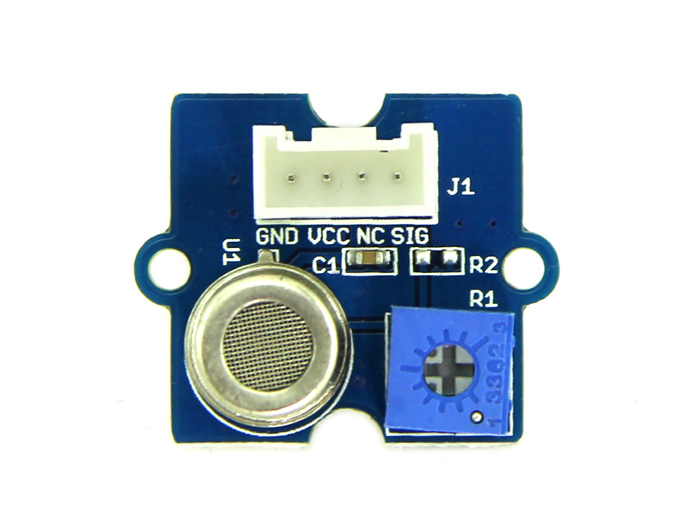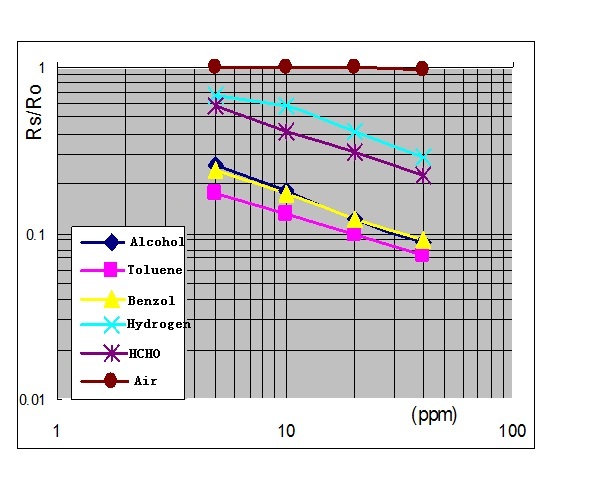Grove : capteur de formaldéhydes (HCHO)
De Wikidebrouillard.
(→Demonstration) |
|||
| Ligne 1 : | Ligne 1 : | ||
==Introduction== | ==Introduction== | ||
| - | The Grove - HCHO Sensor is a semiconductor VOC gas sensor. Its design is based on WSP2110 whose conductivity changes with the concentration of VOC gas in air. Through the circuit, the conductivity can be converted to output signal that corresponding to the gas concentration. This sensor has a very high sensitivity and stability, it can detect the gas whose concentration is up to 1ppm. It’s suitable for detecting formaldehyde, benzene, toluene and other volatile components. This product can be used to detect harmful gas in the home environment. Therefore, it’s a good assistant for you to improve indoor environment quality of life. | + | The Grove - HCHO Sensor is a semiconductor VOC gas sensor. Its design is based on WSP2110 whose conductivity changes with the concentration of VOC gas in air. Through the circuit, the conductivity can be converted to output signal that corresponding to the gas concentration. This sensor has a very high sensitivity and stability, it can detect the gas whose concentration is up to 1ppm. It’s suitable for detecting formaldehyde, benzene, toluene and other volatile components. This product can be used to detect harmful gas in the home environment. Therefore, it’s a good assistant for you to improve indoor environment quality of life. |
| - | '''Model:'''[http://www.seeedstudio.com/depot/grove-hcho-sensor-p-1593.html SEN01500P] | + | |
| + | '''Model:'''[http://www.seeedstudio.com/depot/grove-hcho-sensor-p-1593.html SEN01500P] | ||
| + | |||
[[File:HCHO Sensor 01.jpg|center]]<br> | [[File:HCHO Sensor 01.jpg|center]]<br> | ||
==Specification== | ==Specification== | ||
| - | Operating Voltage: 5.0V ± 0.3V | + | * Operating Voltage: 5.0V ± 0.3V |
| - | Target Gases: HCHO, Benzene,Toluene,Alcohol | + | * Target Gases: HCHO, Benzene,Toluene,Alcohol |
| - | Concentration Range: 1~50 ppm | + | * Concentration Range: 1~50 ppm |
| - | Sensor Resistance Value(Rs): 10KΩ-100KΩ(in 10ppm HCHO) | + | * Sensor Resistance Value(Rs): 10KΩ-100KΩ(in 10ppm HCHO) |
| - | Sensitivity: Rs(in air)/Rs(10ppm HCHO)≥5 | + | * Sensitivity: Rs(in air)/Rs(10ppm HCHO)≥5 |
==Demonstration== | ==Demonstration== | ||
| - | The Grove - HCHO Sensor can be used to detect VOCs, such as HCHO,toluene, benzene, alcohol. Here we take alcohol for an example to demonstrate how to use this sensor. | + | The Grove - HCHO Sensor can be used to detect VOCs, such as HCHO,toluene, benzene, alcohol. Here we take alcohol for an example to demonstrate how to use this sensor. |
[[File:HCHO Hardware Connection.jpg|center]] | [[File:HCHO Hardware Connection.jpg|center]] | ||
| Ligne 34 : | Ligne 36 : | ||
</pre> | </pre> | ||
After uploading the code, open the serial monitor to get the voltage(Vol) under normal condition. | After uploading the code, open the serial monitor to get the voltage(Vol) under normal condition. | ||
| - | + | ||
| + | [[File:Test result1.jpg|center]] | ||
Now list out the formula describing the relationship of Vol and R0: | Now list out the formula describing the relationship of Vol and R0: | ||
| - | ::R0=(Vc/Vol-1)×R1 (Vc=4.95V) ① | + | ::R0=(Vc/Vol-1)×R1 (Vc=4.95V) ① |
Then put a bottle of alcohol near the sensor, and read again the sensor value: | Then put a bottle of alcohol near the sensor, and read again the sensor value: | ||
| - | + | ||
| - | And we get the Rs: | + | [[File:Test result3.jpg|center]] |
| + | |||
| + | And we get the Rs: | ||
| + | |||
::Rs = (Vc/Vol-1)×R1 (Vc=4.95V) ② | ::Rs = (Vc/Vol-1)×R1 (Vc=4.95V) ② | ||
Now calculate Rs/R0. Here we get 0.285. Then refer to the sensitivity characteristic diagram below and find the alcohol concentration is about 5 ppm. | Now calculate Rs/R0. Here we get 0.285. Then refer to the sensitivity characteristic diagram below and find the alcohol concentration is about 5 ppm. | ||
Version du 29 octobre 2013 à 16:22
Sommaire |
Introduction
The Grove - HCHO Sensor is a semiconductor VOC gas sensor. Its design is based on WSP2110 whose conductivity changes with the concentration of VOC gas in air. Through the circuit, the conductivity can be converted to output signal that corresponding to the gas concentration. This sensor has a very high sensitivity and stability, it can detect the gas whose concentration is up to 1ppm. It’s suitable for detecting formaldehyde, benzene, toluene and other volatile components. This product can be used to detect harmful gas in the home environment. Therefore, it’s a good assistant for you to improve indoor environment quality of life.
Model:SEN01500P
Specification
- Operating Voltage: 5.0V ± 0.3V
- Target Gases: HCHO, Benzene,Toluene,Alcohol
- Concentration Range: 1~50 ppm
- Sensor Resistance Value(Rs): 10KΩ-100KΩ(in 10ppm HCHO)
- Sensitivity: Rs(in air)/Rs(10ppm HCHO)≥5
Demonstration
The Grove - HCHO Sensor can be used to detect VOCs, such as HCHO,toluene, benzene, alcohol. Here we take alcohol for an example to demonstrate how to use this sensor.
// demo of Grove - HCHO Sensor
void setup()
{
Serial.begin(9600);
}
void loop()
{
int sensorValue=analogRead(A0);
float Vol=sensorValue*4.95/1023;
Serial.print("Vol = ");
Serial.println(Vol);
delay(500);
}
After uploading the code, open the serial monitor to get the voltage(Vol) under normal condition.
Now list out the formula describing the relationship of Vol and R0:
- R0=(Vc/Vol-1)×R1 (Vc=4.95V) ①
Then put a bottle of alcohol near the sensor, and read again the sensor value:
And we get the Rs:
- Rs = (Vc/Vol-1)×R1 (Vc=4.95V) ②
Now calculate Rs/R0. Here we get 0.285. Then refer to the sensitivity characteristic diagram below and find the alcohol concentration is about 5 ppm.
Resources
Grove - HCHO Sensor Eagle File
Support
If you have questions or other better design ideas, you can go to our forum or wish to discuss.
Crédits
Cette page est la traduction de celle-ci : http://www.seeedstudio.com/wiki/Grove_-_HCHO_Sensor
Traducteurs : machine et bidule - 2013 dans le cadre de Master 2 rédacteur traducteur 2013






